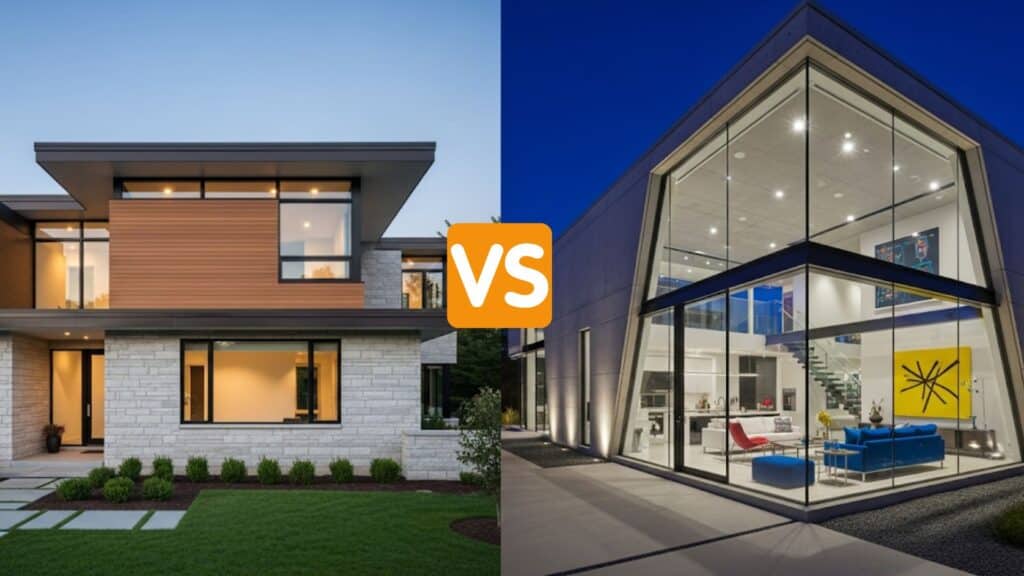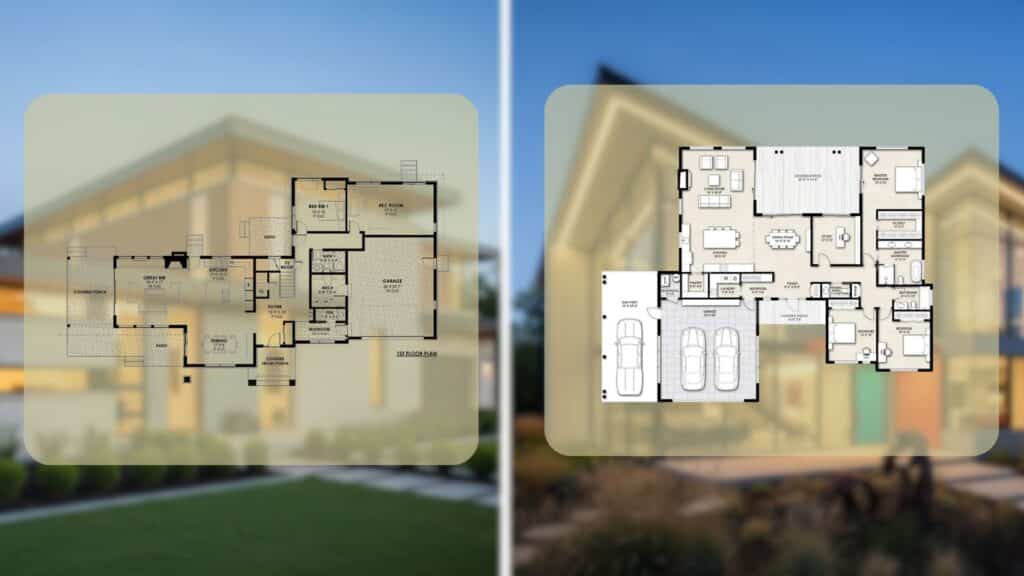Are you confused about what makes contemporary house design different from modern style? I know many homeowners mix up these two terms because they both sound like they mean new or current.
The truth is that modern design comes from a specific time period, while contemporary house design keeps changing with today’s trends and technology.
People often use these words interchangeably when discussing home styles, which can lead to confusion. I aim to clarify this mix-up and help you understand what each style actually means.
I’ll tell you the key differences, benefits, and challenges of both approaches to home design. Making the right choice for your home begins with understanding what sets these styles apart.
What is Contemporary House Design?
Contemporary home design reflects current style and trends in structure. Unlike other design styles, contemporary design continually develops and adapts to current times and technology.
It’s the design of the present moment, always adapting to new ideas. These homes feature large windows that bring natural light and connect indoor spaces with the outdoors.
Eco-friendly materials are essential, showing care for the environment and sustainable living practices. Minimalist details keep spaces clean and uncluttered while focusing on function over decoration.
Contemporary design prioritizes sustainability through the integration of energy-efficient systems and smart home technology. You’ll see innovative urban homes with sleek lines and modern materials.
Minimalist, eco-friendly homes utilize natural resources efficiently while maintaining beautiful interiors. Glass-heavy structure creates open environments that feel spacious.
What is Modern Home Design?
Modern home design emerged during the early to mid-twentieth century as part of the Modernist movement. This design style has fixed characteristics that remain unchanged by current trends, unlike contemporary design.
Modern design focuses on principles that have stayed consistent for decades. These homes feature clean lines without unnecessary decoration.
Functional layouts prioritize how people live and move through spaces on a daily basis. Open spaces connect areas while eliminating walls that separate rooms.
Natural materials like wood, stone, and steel are essential elements in modern design. You’ll see mid-century modern homes with flat roofs and large windows.
The Bauhaus influence is evident in the use of geometric shapes. Ranch-style homes represent modern design with low profiles.
Contemporary vs. Modern Home Design: Key Differences

Modern and contemporary designs might sound similar, but they represent completely different approaches to home structure. I’ll break down the main differences so you can tell them apart:
1. Timeframe and Origins
Modern design comes from a specific historical period in the early twentieth century. This style stays true to its original Modernist movement roots and principles.
Contemporary design reflects whatever structural trends are popular right now in society. Modern has fixed historical boundaries, while contemporary keeps moving forward with time.
2. Design Philosophy
Modern homes prioritize function above all other design considerations in every room and space. Every element serves a practical purpose without unnecessary decoration or fancy additions.
Contemporary homes welcome experimentation and adaptation to whatever works best for current lifestyles. Modern follows strict rules while contemporary breaks them when needed.
3. Materials and Finishes
Modern homes stick to natural, earthy materials that connect people with the outdoors. Wood, stone, and other organic elements create warm, grounded feelings in living spaces.
Contemporary homes blend steel, glass, concrete, and sustainable options together in creative combinations. Modern uses traditional materials, while contemporary uses innovative options constantly.
4. Layout and Space
Modern homes feature balanced, straightforward layouts that make sense for everyday family living. Rooms flow logically from one to another without confusing or complicated floor plans.
Contemporary homes often feature flexible, open-concept designs that can adapt as families grow. Modern creates predictable layouts, while contemporary designs remain fluid and adaptable.
5. Color Palette
Modern homes often feature warm neutrals and earth tones, creating a calm atmosphere. Browns, beiges, and muted colors create peaceful environments that never go out of style.
Contemporary homes feature bold contrasts, crisp whites, and trend-driven palettes that make strong statements. Modern chooses safe colors while contemporary takes bold risks with dramatic combinations.
Weighing Your Design Options: Pros and Cons
Both design styles have clear advantages and drawbacks that affect your daily life. Here are the main benefits and challenges you should know about:
Contemporary Home Design
Contemporary design offers different benefits and challenges than modern style. Here’s a quick look at both sides:
| Pros | Cons |
|---|---|
| Reflects your personal taste and current lifestyle | Harder to sell to buyers with different tastes |
| Energy bills tend to be lower monthly | Requires research to pick good-quality new materials |
| Can include the newest safety features available | May need permits for unusual design elements |
| Impressive to guests and visitors | Can clash with older neighborhood architecture |
| Allows for unique layouts that fit your family | Repair costs might be higher for specialty materials |
Contemporary design suits those who enjoy experimenting with new ideas. This approach gives you more creative freedom but requires careful planning.
Modern Home Design
Understanding modern design helps you make smart choices for your home. The following are the key points to consider:
| Pros | Cons |
|---|---|
| Lower maintenance costs over time | It can be expensive to heat and cool |
| Wide variety of furniture options available | Hard to personalize with family photos and decorations |
| Good resale value in most markets | May not suit large families with lots of stuff |
| Appeals to buyers who want move-in ready homes | Windows can lack privacy from neighbors |
| Works well in both urban and suburban settings | Storage space might be limited |
Modern design works best when you prioritize simplicity and long-term value. This style suits people who prefer classy looks over trendy features.
How to Choose Between the Two Plans

Start by thinking about your family’s daily life and future plans. Modern house plans work well for families who want stable, predictable layouts that won’t change much.
Contemporary house plans suit people who like flexibility and adapting to spaces as their lives change. Consider your location and sustainability goals when making this decision.
Contemporary designs often utilize newer, eco-friendly materials and energy-saving technology, which can be more expensive upfront. Modern house plans prioritize materials that are more cost-effective.
Budget plays a big role in choosing between these design approaches. Your personal taste matters; some people love classy looks, while others prefer trendy features.
Many homeowners combine elements from both contemporary house plans and modern house plans to create unique hybrid designs.
Final Words
Modern design offers stability and classy attraction, while contemporary house design provides flexibility and current technology.
Both styles have unique benefits that suit different lifestyles, budgets, and personal preferences for living spaces. Modern homes work well for families who want predictable layouts that last for decades.
Contemporary house design suits people who enjoy adapting their spaces and using the latest innovations.
The key is to pick a style that matches how you live and what you want in the long term. Your home should support your daily routines and future goals rather than work against them.
Drop a comment below and let me know which contemporary house design features caught your eye!














